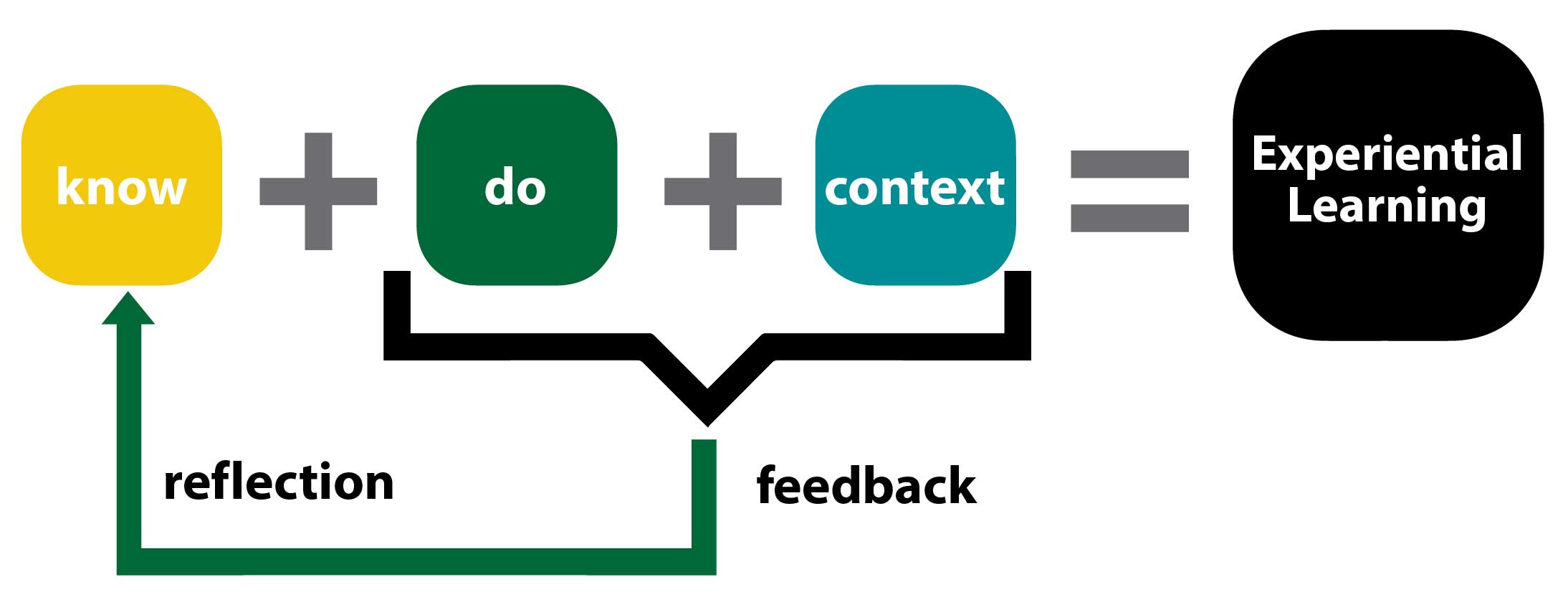Overview
Experiential Learning (EL) enhances student knowledge by integrating doing in a rich context with opportunities for feedback and reflection. It is an engaging approach to teaching and learning that can be extremely beneficial for students, especially as they start their careers. Due to practical limitations, EL can’t always be used, which leads to the question: when should you use EL?
Some skills taught in university courses are critical for students to perform successfully in their careers after graduation. These skills should be taught using EL. To identify these skills, you should review your program level outcomes, connect with recent graduates, talk to your disciplinary community, and/or reflect on the core skills of your discipline.
Many processes require practice, feedback, and iteration to learn. If these processes are important for students to master, then you should use EL. Within EL, students perform activities, receive feedback, and complete facilitated reflection. The reflection stage moves them through a process of considering what they did, how it went, and what they’ll do differently next time. As a result, they are prepared to do better the next time they practice the process. The best EL implementations provide multiple opportunities for students to practice until they reach mastery.
Students often identify a gap between what they learn in the classroom (i.e., what they know) and what they are expected to do (i.e. to demonstrate their learning). They may feel like they understand what they've been learning and may even do well on an exam, but when they go to apply the learning in an authentic context, they struggle. If you've noticed this happening, you have a great opportunity to integrate EL into your course. EL provides students with the opportunity to practice and apply their learning in authentic contexts and navigate authentic variables they will likely encounter. The authentic context could be a complex work placement, but it doesn't need to be. There are more accessible ways to provide an authentic context to all students, such as role plays, simulations, case studies, laboratories, or short-term projects with external partners.
Key Components of EL
Learning typically results in increased student knowledge. In Experiential Learning (EL), students’ knowledge is accompanied by competency in applying the knowledge skillfully because of four essential elements of EL:
- Doing - Students apply their knowledge by doing (active learning) in a situation with some unpredictable factors that require student decision-making.
- Context - The application occurs in an authentic context, where students need to make decisions about what is important and the best path forward. This may include an authentic problem, a real client whom students will help, or an audience beyond the class.
- Feedback - Students get information about how well they are learning as the learning occurs, and adjust their thinking, actions etc. in response as they learn.
- Reflection - Students consider the success of their approaches, generalizing what worked and considering how to improve as they learn.

Types of EL
Experiential learning occurs in the intersection between the disciplinary domain and the context of the experience.
- Domain refers to the types of disciplinary praxis (thinking and practice combined) that underly disciplinary competency.
- Context, the place where the EL occurs, shapes the types of experiences and their relative complexity.
Examples connected to Indigenization, internationalization, and sustainability are indicated in bold with an asterisks*, recognizing that all experiential learning helps work towards better ways of knowing, doing, and being for people, planet, and prosperity.
|
|
Work or entrepreneurship |
Research |
Problem or project |
Community-engaged or service |
Creative |
|
In class |
|||||
|
In |
Skills lab |
Creating a prototype or solution |
Create an artefact (sculpture, improv) Language lab* |
||
|
In workplace, community |
Design challenge with industrial commercial institutional partners |
Gallery, exhibit, performance |
* Indicates the example is connected to Indigenization, internationalization, and/or sustainability.
Resources for EL
- How to know when you need EL?
- Give efficient feedback
- Grading reflection
- Iterative Learning: Practice & Feedback Loops in the Draft Process (YouTube)
- Reflection in the Learning Process (YouTube)
- EL Resources - 5 Top Picks
- Add FUSION Skill Development Modules to your learning opportunity
Get Support
To get help designing your EL contact the Gwenna Moss Centre for Teaching and Learning
To consult about connecting with industry and community partners, contact Career Services

